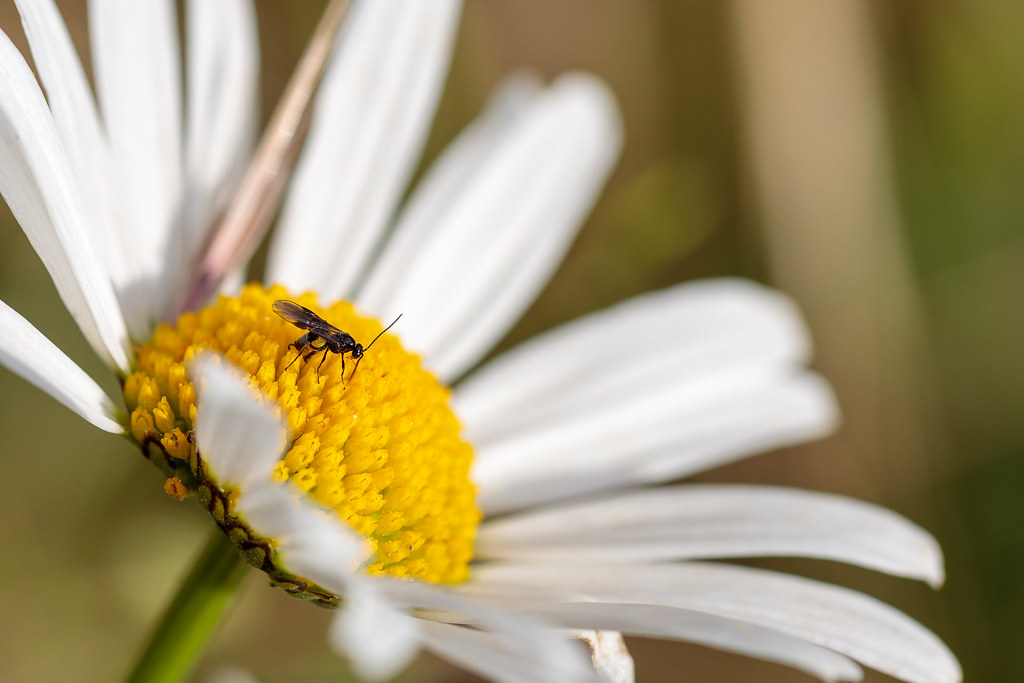#braconid
Video
Braconid Wasp by Oliver Andrews
Via Flickr:
A tiny braconid wasp, exact species unknown, probing an ox eye daisy flower for things to lay eggs in.
#30dayswild#braconid#braconidae#canon#canonuk#fauna#garden#insect#insects#invertebrate#invertebrates#minibeast#minibeasts#nature#outdoors#springwatch#wildlife#flickr
4 notes
·
View notes
Text
#2038 - Callibracon sp.

Photo by Patrick Wake.
Callibracon wasps are widespread in Australian, and tend to come in variations of black, white, red and yellow. At least some are known to be parasitoids of Eucalyptus Longicorn Beetles in the genus Phoracantha.
1 note
·
View note
Text
Matt Birds dominating cock rock Lady Dees dripping wet pussy until he busts a dripping load all over her lips
Arab sex new Easing Daddys Tension
Topless Beach Massage in New York
hard fucking sister in the bedroom
Hot milf fisting mature playmate while cuckold husbands watch
masturbate my hard cock with vibrator in ass and nipple clips and cock ring
Hard pussy fucking leads to raunchy rectal reaming packed with filthy food play
GF - Ebony Teen Petite Takes BFs White Cock In Hotel - BCWD
Samantha Saint sexual gets satisfied by a big dick
Carona de Don Picone e sexo ao ar livre com Diana Gaucha
#rilawa#braconid#Sundberg#limper#canabis#carvage#xray#thalamomammillary#Pageton#autacoid#salicylanilide#intradermo#unsceptre#hemiparalysis#fow#well-arranged#Liaoning#secularistic#translated#aperitifs
0 notes
Photo

Spun glass slug moth caterpillar (Isochaetes beutenmuelleri) with attached cocoons from parasitoid wasps
Parasitoid braconid wasps will lay eggs on or into host caterpillars. The eggs hatch and the wasp larvae live inside and feed on the caterpillar’s body. The larvae then emerge and spin a cocoon attached to the caterpillar to pupate inside. The host caterpillar is usually killed, though sometimes they manage to pupate first.
Photo by lyndawill777
#animals#curators on tumblr#insects#bugs#caterpillar#moth#larva#slug moth caterpillar#slug moth#spun glass slug moth#parasite#parasitoid#wasp#braconid wasp#bug death#one nice bug
506 notes
·
View notes
Text
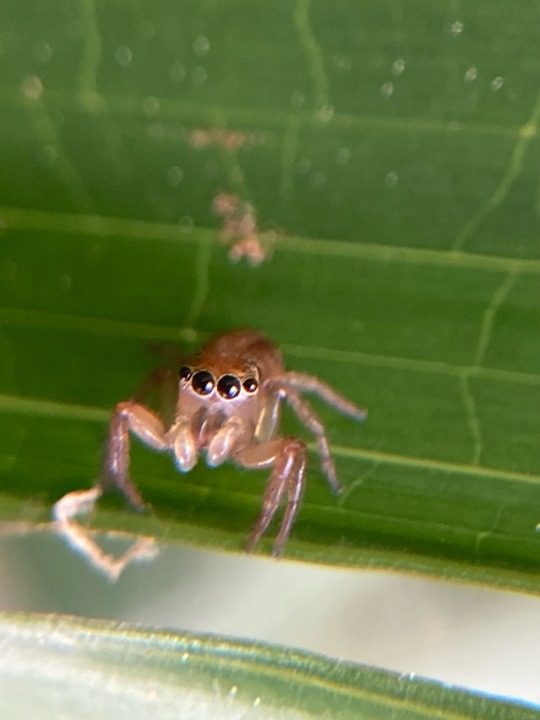

little jumping spider (prostheclina) and the braconid wasp (callibracon) several times its size that it tried and failed to eat. the wasp didn't even fly away
25 notes
·
View notes
Photo

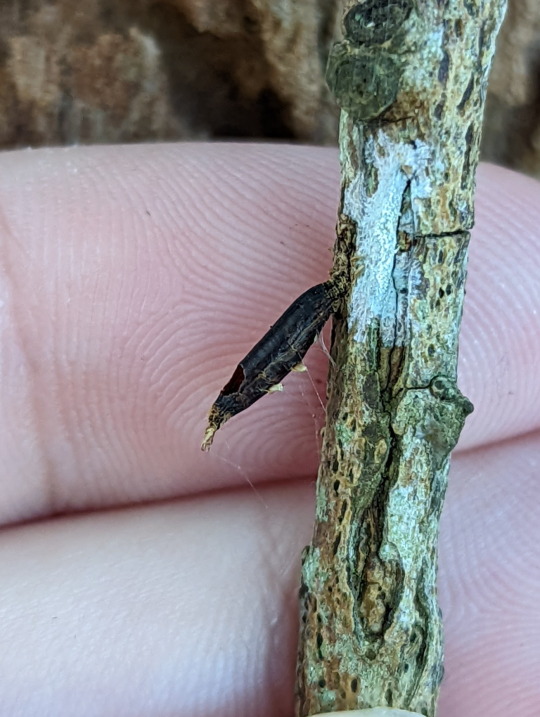

Parasitic Wasp Pupae
When I first found this strange pupae, I was just left baffled. On second viewing however, I believe this may be the remains of a mummified caterpillar. You can still see the prolegs, and the swollen body is very akin to wasp mummification.
If you are unfamiliar with this process, it’s quite similar to other forms of wasp parasitism:
The female wasp lays her eggs inside the caterpillars body
The wasp larva eats the caterpillar from the inside
What’s left is the caterpillar’s skin, which hardens into a shell
The wasp larva pupates inside the caterpillar
Finally, the adult wasp hatches out of the caterpillar, leaving a distinct circular hole
(Another example of this)
Although this is a very morbid death, I must be clear that without wasps like these, caterpillars will quickly overrun every single plant. Natural pests like these are very much needed.
Parasite - Unidentified, Subfamily Rogadinae (?)
Parasite Host - Unidentified, Order Lepidoptera
01/06/22
#mummification#Mummy Wasps#parasitism#pupae#Braconidae#Braconid Wasps#Ichneumonoidea#parasitic wasps#Apocrita#pupa#hymenoptera#wasps#Arthropods#Arthropoda#bugblr#bugs#bugs tw#bug#insects#insectblr#insect#insects tw#entomology#nature
24 notes
·
View notes
Text
At A Crossroads In Life

A Braconid Wasp pausing and wondering which way to take in a local park. Photo credit: Eleanor Chua.
This was captured at the ISO of 5000 and the resultant noise level at 8 odd in this downsized image was rather unexpected out of a full-frame sensor.
#photographers on tumblr#Braconid wasps#canon eos rp#canon photography#flora fauna#insect pics#macro photography#photography tips#tamron 16-300mm#wasp photos
0 notes
Text
Something people might be interested in since my friends didn't know: there's this little parasitoid wasp, Copidosoma (Encyrtidae) that has larvae with castes, like ants!
Copidosoma is a polyembryionic wasp, which means many larvae can emerge from a single egg, which in their case is laid in caterpillars. The cool part is that some of these larvae are neither male nor female, but sterile workers that will never become adults, and only exist to defend their siblings by attacking competing larvae chemically AND physically.
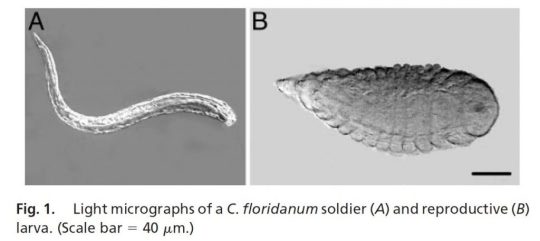
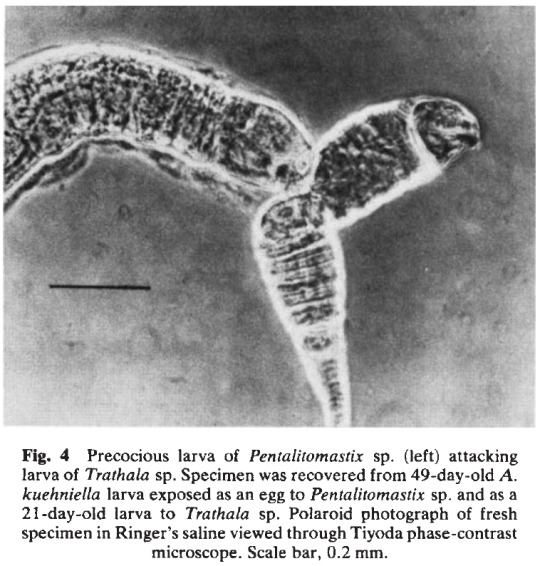
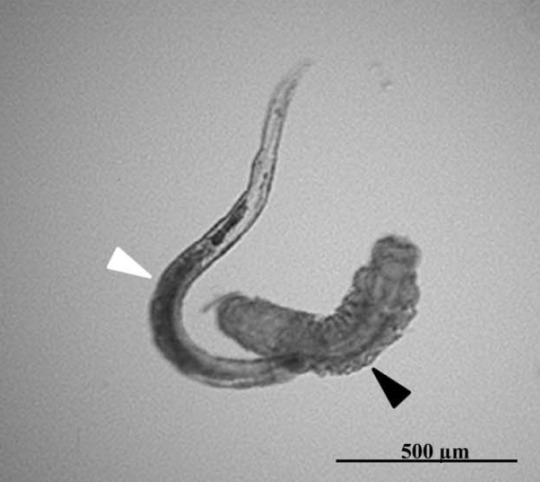
In these photos you can see the slender, sexless soldier larvae, and the more typical looking reproductive grub, plus two example images of the soldier attacking larvae of competitor species. Again all this happens inside the eggs and bodies of caterpillars! These things aren't even rare, my boss did his dissertation on this family and described them as "common as dirt". They're used in pest control as a natural enemy. This is a very common species that exists all over the world, almost entirely unnoticed because they're just so small and inconspicuous.
They're not even the only parasitoids that have hit on this either, here's a slide I enjoyed from a PowerPoint I saw at the national ESA meeting. Tragically I have forgotten the authors of this presentation tho..

Update: this paper is about competition between braconids Cotesia glomerata and rubecola and is not the same thing as what's going on in Copidosoma, but does still involve baby on baby violence in the flesh of a living caterpillar.
795 notes
·
View notes
Note
hello! i am a relatively new user here on tumblr, less than a year, and i have heard a comment or two about a 'wasp discourse' that happened here, that wasps are much more nice than bees or something among those lines
this caught my curiosity as im writting a wasp based character whos just an ahole as i did it on what i knew abt them from general internet and im stuck on wether i should maaayybe change them up a bit
if its not too much to ask do you happen to know a bit abt this discourse? or have a link to it? or if not to the discourse itself some other link that elaborates abt the same topic? perhaps even someone else i can ask this?
thank you very much!
to start off, there are a lot of bees and wasps in this world and it is not easy to generalize about them. there are ~20,000 bee species, and the vast majority of these are solitary bees that nest in the ground, plant stems, or in holes in wood, and because they produce no honey or have a colony to guard, have no need to be defensive or aggressive towards humans (because “towards humans” seems to be what most people base this idea off of). colonial bees, like honeybees, are actually much more defensive than solitary ones; they have huge food stores and many defenseless larvae, hence their nasty stings (or bites, for the stingless bees) and swarm defense of their hives.
bees, however, are just a family of wasps. their closest relatives are believed to be the crabronid wasps (example: cicada killers) and sphecid thread-waisted wasps (ex. mud daubers). these wasps, and most others, are also largely solitary, and hunting prey aside, don’t typically use their stings for anything other than personal defense. of the hundreds of thousands of wasps, most of them (75%) are not just solitary but also parasitoids that develop inside other insects. it’s hard to say “all wasps are assholes [to people]” when some 100,000 of them are tiny specks smaller than sesame seeds that nobody other than scientists notice.
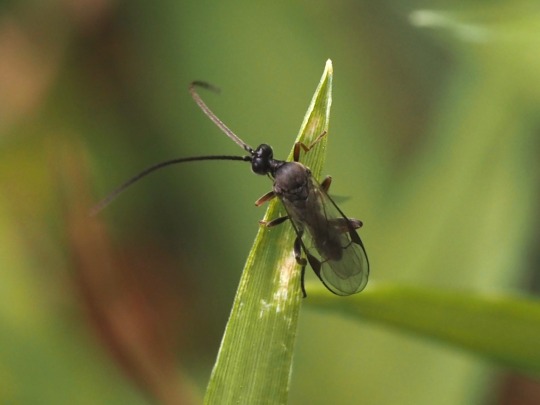

two parasitoids: a braconid ~3mm long & something else ~0.3mm long
the wasps most people take issue with are vespids, since they like the same foods we do (sweets, meat) and have powerful stings to defend their nests. these include the social hornets, yellowjackets, and paper wasps, but many mason wasps and the like are solitary (and, you guessed it, want nothing to do with people). vespids are great predators of caterpillars, flies, and other pests that humans don’t like in addition to being pollinators.
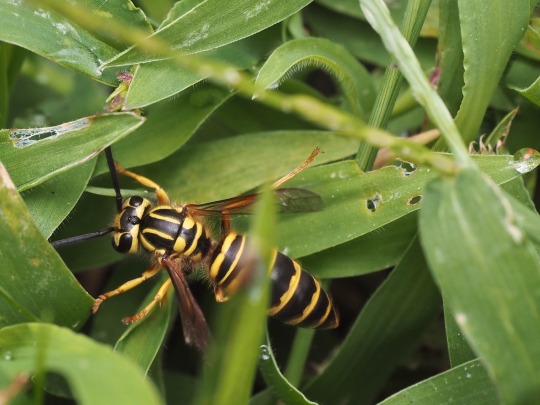
a yellowjacket: Vespula squamosa
the usual anti-wasp, pro-bee sentiments go: wasps attack for no reason, don’t pollinate, don’t make honey, and are “assholes.” wasps do pollinate (most wasps, bees and ants don’t eat solid food, and therefore largely drink flower nectar; some plants are only pollinated by wasps).
some tropical wasps do actually make honey, though it’s not harvested by humans. it’s sort of silly to say that making honey is what makes bees “good” though—a very selfish mindset, and for example butterflies are well-liked by people despite not making any edible products for us.
wasps also attack only when provoked, either because you’re near a wasp nest or when you lean on one accidentally. they are defending their baby sisters and themselves, same as bees would. at least in the US, I think the reason that wasps are so hated is that we have many species of paper wasp and yellowjacket that are willing to nest on or under houses, while the (invasive) honeybees prefer trees or are kept by beekeepers in artificial hives, so it’s just more likely you’ll run into problems with wasps than bees.
tl;dr:
wasps and bees are neither “nice” nor “mean.”
bees are mostly loners that don’t bother people. colonial bees will sting to defend their nests or themselves from predators. most bees are pollinators, who gather pollen to feed their larvae. a few species make honey that humans harvest.
wasps are mostly loners that don’t bother people. colonial wasps will sting to defend their nests or themselves from predators. most wasps are pollinators, and most hunt or parasitize other insects to feed their larvae.
1K notes
·
View notes
Photo

Braconid Wasp Eggs and Ant
Photo taken in Millersville, MD
04/08/2022
Photography by Nisha Wolfe
1 note
·
View note
Text
Day 23 of my 2023 favorites: Ball-winged Braconid Wasps!
So last year I found one of the dark colored ball-winged braconids (Hoplitalysia slossonae), this year I found another, and then a couple orange mystery braconids who were also sporting ball wings! They're just bizarre and I love them 🧡




342 notes
·
View notes
Text
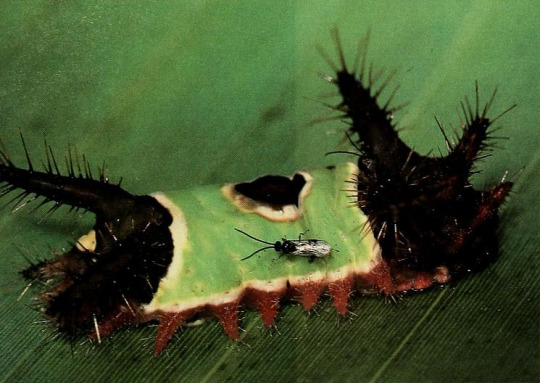
A braconid wasp laying eggs on a saddleback moth caterpillar
By: Raymond A. Mendez
From: Natural History Magazine
1984
#parasitism#wasp#hymenopteran#insect#arthropod#invertebrate#moth#1984#1980s#Raymond A. Mendez#Natural History Magazine
107 notes
·
View notes
Text

I had mentioned artwork regarding Braconid wasps a little while ago, that I was working on some project, and this is the final result. My cartoon made it in Zookeys! Ha! It's a long paper, but my drawing is closer to the bottom, with 100% credit given and even linked my cartoon page on Facebook! I thought that was pretty neat to see before 7am this morning! Worth a read to those interested.
74 notes
·
View notes
Note
Trick or treat!! 👻🫀🍬🎃
Happy halloween! Did you know there are several different species of wasp that are aquatic? Notably, this includes a relatively recently discovered species of wasp called "Microgaster godzilla" (source)! Obviously, this species is named after Godzilla, and is a known parasitoid of Elophila turbata caterpillars

[Image sourced from: ResearchGate, as uploaded by Kaoru Maeto | Image ID: A collection of photos of a female holotype of Microgaster godzilla, a small black and yellow braconid wasp /End ID.]
20 notes
·
View notes
Note

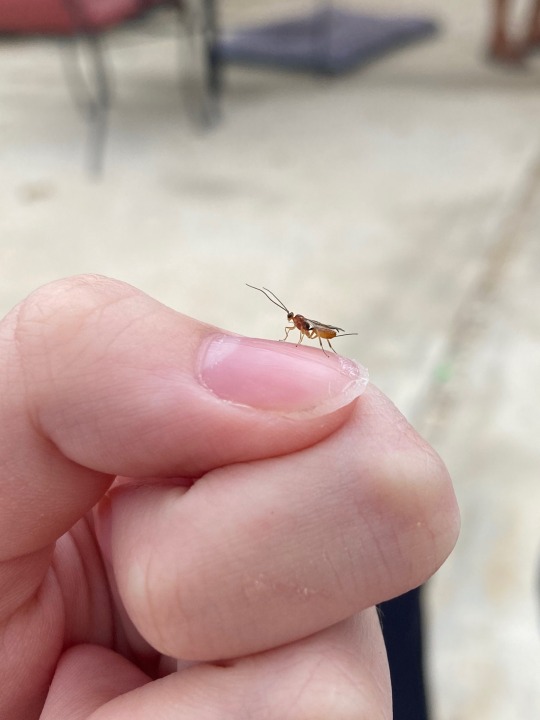
found this guy at a family member’s house a while back, any idea what it might be? it was stuck upside down on a leaf when i found it n i think its wings mightve been damaged when it got stuck so thats why they look a little weird in the pictures
found it in southern california if that helps
An angel!! She's a wasp although I am not great at IDing tiny wasps. Maybe a Braconid. Either way given the size she's likely a parasitoid! I love her deeply and I hope she was okay...
148 notes
·
View notes
Text

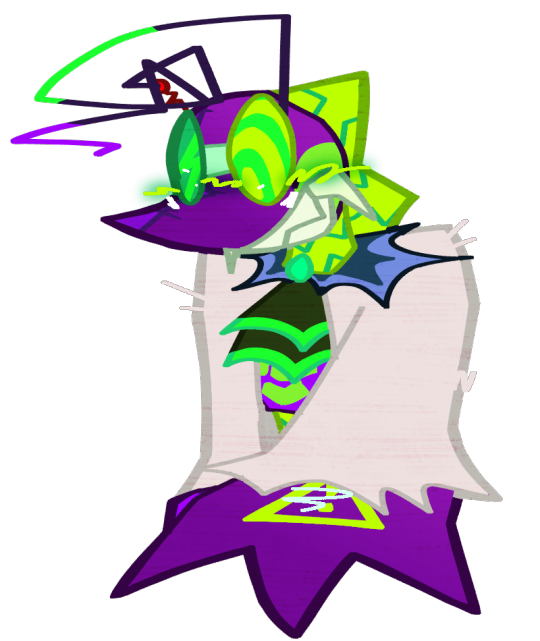
JUST CLOSE YOUR EYES AND METAMORPHOSIZE 🎵
once per year i get the need to make actual ref sheets for my ocs. say hi to dr distemper!! little lonely freak of a mad scientist who was created as an experiment themselves; but escaped the lab just to start rads own.
living underground in a sprawling lab they dug out radself, they only really have the company of the mice and rats rad experiments on, and are desperately hoping for some company...
anyway did you know that some species of braconid wasps are resistant to radiation and can withstand radiation levels far beyond what could kill a human?
#the beasts#dr. distemper#oc#original character#insect oc#parasitoid wasp#wasp oc#insect character#artists on tumblr#digital art#i love making wasp ocs and i love making mad scientist ocs#so obviously this guy was the culmination of that#i made them over a year ago but rads one of my favourites#ive always thought parasitoid wasps and polydnaviruses are cool as hell so#yeah .#anyway look at my guy i love them soo much
12 notes
·
View notes
